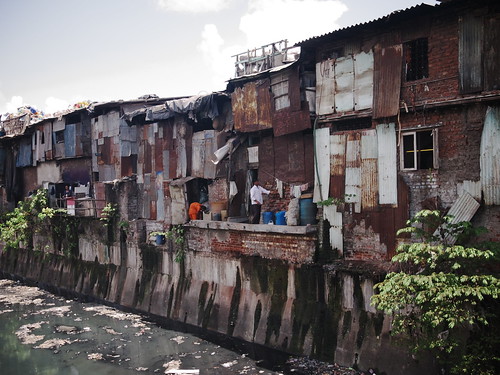Sunday, June 6, 2010
Mumbai has been interesting, though I'm a few days behind on the blogging. This is largely because I've been traveling with some people I met in the hostel, so I've had little time to update but have taken more pictures than usual (taking pictures is way more comfortable when others around you are doing the same).
A few days ago, I visited Dharavi, which is Mumbai's largest slum, and supposedly Asia's as well. Around one million people live and work within an area just over half a square mile in size. It's a prime example of informal building, with houses built up on each other from any available material, on land owned by the city.
One of the more interesting parts of Dharavi is called the 13th Compound, where an impressive recycling and repair industry generates over 500 million USD a year. The 13th Compound recycles plastic and aluminum, while repairing many industrial containers used to ship paint and vegetable oil. Leather tanneries and shops are another large sector and Ive heard rumors that some of the finest upscale brands source many of their products here, which is really not that surprising. Most of the recycling practices are highly toxic, combined with the fact that the workers dont use any special equipment or safety gear, preferring instead to use their bare hands because it allows them to work quicker.
In my mind, it represents the hidden side of global consumption. Somewhere, usually in the third world, the breakdown and recycling of goods takes place in areas much like Dharavi, where the abundance of cheap labor makes recycling very cost-effective. But the labor force required to sort and break down these products is staggering.
Various plastics, for example, are collected and shipped to Dharavi where they are broken down with hammers and chisels, sorted into different types and colors. then pulverized into smaller pieces by large machines made in Dharavi. (These machines are even exported to similar recycling towns throughout Asia.) From here, they are washed and laid to dry on the roofs. Once dry, the plastic is collected and placed in baths of dye, before being melted down. The melted plastic is then run through another machine that spins it into long ropes of wire, which are then fed through a machine that chops it into very fine pellets. This new raw material is then collected and bagged for shipping, in a variety of colors.
From here, in many cases, the same company that dropped off the disposed-of plastic returns to collect the raw product for manufacturing new items (which will eventually be thrown away and shipped back to Dharavi). It's a factory assembly line (or disassembly line), but instead of going home at the end of the day, you crawl above your work station and sleep there, together with most of your coworkers.
It's a disheartening visit, but important. The slum itself is very rough, with a massively polluted river moving through on its way to the Indian Ocean. There are very few toilets, each being used by literally thousands of people throughout the day. Garbage piles can be found throughout, fouling up all open space. I dont think there are more than 5 trees across the whole area.
The boy that took several of us through the 13th Compound stressed the importance of the community that develops within the slums, where no one has an address. After visiting Dharavi, I can see why. It seems that only a rich community could let such a place endure the way it has.
Subscribe to:
Post Comments (Atom)

No comments:
Post a Comment